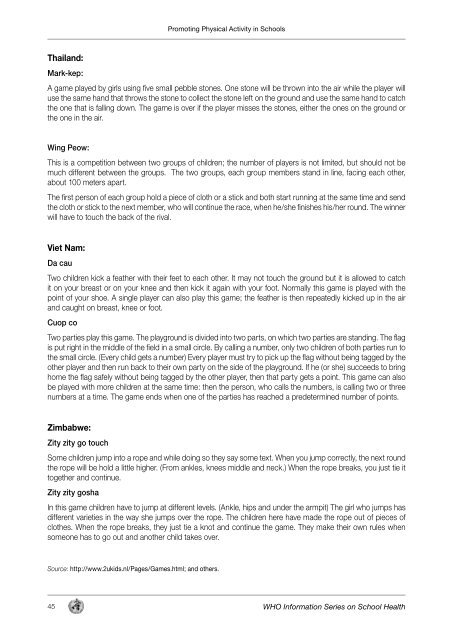WHO INFORMATION SERIES ON SCHOOL HEALTH ... - PAHO/WHO
WHO INFORMATION SERIES ON SCHOOL HEALTH ... - PAHO/WHO
WHO INFORMATION SERIES ON SCHOOL HEALTH ... - PAHO/WHO
You also want an ePaper? Increase the reach of your titles
YUMPU automatically turns print PDFs into web optimized ePapers that Google loves.
Thailand:<br />
Mark-kep:<br />
45<br />
Promoting Physical Activity in Schools<br />
A game played by girls using five small pebble stones. One stone will be thrown into the air while the player will<br />
use the same hand that throws the stone to collect the stone left on the ground and use the same hand to catch<br />
the one that is falling down. The game is over if the player misses the stones, either the ones on the ground or<br />
the one in the air.<br />
Wing Peow:<br />
This is a competition between two groups of children; the number of players is not limited, but should not be<br />
much different between the groups. The two groups, each group members stand in line, facing each other,<br />
about 100 meters apart.<br />
The first person of each group hold a piece of cloth or a stick and both start running at the same time and send<br />
the cloth or stick to the next member, who will continue the race, when he/she finishes his/her round. The winner<br />
will have to touch the back of the rival.<br />
Viet Nam:<br />
Da cau<br />
Two children kick a feather with their feet to each other. It may not touch the ground but it is allowed to catch<br />
it on your breast or on your knee and then kick it again with your foot. Normally this game is played with the<br />
point of your shoe. A single player can also play this game; the feather is then repeatedly kicked up in the air<br />
and caught on breast, knee or foot.<br />
Cuop co<br />
Two parties play this game. The playground is divided into two parts, on which two parties are standing. The flag<br />
is put right in the middle of the field in a small circle. By calling a number, only two children of both parties run to<br />
the small circle. (Every child gets a number) Every player must try to pick up the flag without being tagged by the<br />
other player and then run back to their own party on the side of the playground. If he (or she) succeeds to bring<br />
home the flag safely without being tagged by the other player, then that party gets a point. This game can also<br />
be played with more children at the same time: then the person, who calls the numbers, is calling two or three<br />
numbers at a time. The game ends when one of the parties has reached a predetermined number of points.<br />
Zimbabwe:<br />
Zity zity go touch<br />
Some children jump into a rope and while doing so they say some text. When you jump correctly, the next round<br />
the rope will be hold a little higher. (From ankles, knees middle and neck.) When the rope breaks, you just tie it<br />
together and continue.<br />
Zity zity gosha<br />
In this game children have to jump at different levels. (Ankle, hips and under the armpit) The girl who jumps has<br />
different varieties in the way she jumps over the rope. The children here have made the rope out of pieces of<br />
clothes. When the rope breaks, they just tie a knot and continue the game. They make their own rules when<br />
someone has to go out and another child takes over.<br />
Source: http://www.2ukids.nl/Pages/Games.html; and others.<br />
<strong>WHO</strong> Information Series on School Health

















